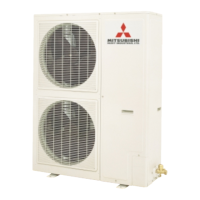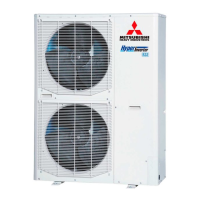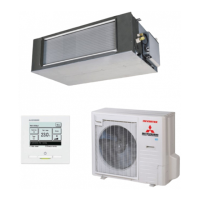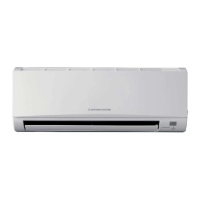[O/U 00▲]
⇔[O/U 01 ]
⇔[O/U 02 ]
⇔ ・・・
⇔[O/U 31▼]
[I/U 001 O/U 01] (1 sec.)
→[ SET I/U ADD.] (1 sec.)
→[I/U001 ] (Blink)
CAUTION
Please make sure that the service valves (gas, liquid) are full open before a test run. Conducing a test run with any
of them in a closed position can result in a compressor failure.
The switch will continuously change the display indication to the next one in every 0.25 seconds when it is pressed for 0.75 seconds or longer.
If the Reset switch is pressed during an operation, the display indication returns to the one that was shown before the last Set switch operation.
Even if an indoor unit No. is changed in this mode, the registered indoor unit No. before address change mode is displayed when [I/U SELECTION
▼
] is shown.
When “SET COMPLETE” is shown, indoor unit No.’s are registered.
⑥
Set a new indoor unit No. with the switch.
A number indicated on the display will increase or decrease by 1 upon pressing the ▲ or ▼ switch
respectively.
④
Pressing the switch will change the display indication cyclically to show the unit
No.’s of the indoor units connected to the remote control and the unit No.’s of the
outdoor units connected with them.
③
Press the Set switch when the display shows “CHANGE ADD. ▼”
The lowest indoor unit No. among the indoor units connected to the remote control unit will be shown.
⑦
Set a new outdoor unit No. with the switch.
A number indicated on the display will increase or decrease by 1 upon pressing the ▲ or ▼ switch
respectively.
④
Set a new indoor unit No. with the switch.
A number indicated on the display will increase or decrease by 1 upon pressing the ▲ or ▼ switch
respectively.
②
Each time when you press the switch, the display indication will be switched.
(2) When plural indoor units are connected to the remote control.
When plural indoor units are connected, you can change their addresses without altering their cable connection.
Address change mode
Selecting an indoor unit
to be changed address
Setting a new indoor unit No.
1
2
3
Setting a new outdoor unit No.
Ending the session
4
5
①
Press the AIR CON Unit No. switch for 3 seconds or longer.
②
Each time when you press the switch, the display indication will be switched.
⑤
Then the address No. of the indoor unit to be changed is determined and the screen switches
to the display “ SET I/U ADD.”
⑦
After selecting an address, press the Set switch. Then the address No.of the indoor unit is determined.
⑧
The display will indicate the determined indoor address No. for 2 seconds and then switch to the
“ SET O/U ADD.” screen.
A default value shown on the display is the current address.
⑨
Set a new outdoor unit No. with the switch.
A number indicated on the display will increase or decrease by 1 upon pressing the ▲ or ▼ switch
respectively.
⑩
After selecting an address, press the Set switch.
Then the address of the indoor unit and outdoor unit are determined.
⑪
If you want to continue to change addresses, return to step
④
.
⑫
If you want to end the session (and reflect new address settings)
In Step
⑩
, press the ▼ switch to select “END ▲.”
If you have finished changing addresses, press the Set switch while “END ▲” is shown. While new
settings are being transmitted, “SET COMPLETE” will be indicated. Then the remote control display
will change to the normal state.
⑬
If you want to end the session (without reflecting new address settings)
Before you complete the present address setting session, press the “ON/OFF” switch.
Then the display is change to exit from this mode and switch the display to the normal state.
All address settings changed in the session will be aborted and not reflected.
[I/U002](2 sec.)
[I/U 002](2 sec. lighting)
⇔[SET O/U ADD.](1 sec.)
⇔[O/U01 ](Blink)
[O/U 00▲]
⇔[O/U 01 ]
⇔[O/U 02 ]
⇔ ・・・
⇔[O/U 31▼]
[I/U 002 O/U 02](2 sec. lighting)
→[SELECT](1 sec. lighting)
→[I/U SELECTION▼](lighting)
[Press the switch](1 sec.)
→[SET COMPLETE](2−10 sec.
lighting)
[END▲]
→[SET COMPLETE](2−10 sec. lighting)
→Normal state
[ON/OFF]
→Forced termination
[SELECT I/U](1 sec.)
→[I/U 001 O/U 01▲](Blink)
[CHANGE ADD▼]
⇔[MASTER I/U▲]
[CHANGE ADD▼]
[I/U 001 O/U 01▲」
⇔[I/U 002O/U 01 ]
⇔[I/U 003O/U 01 ]
⇔ ・・・
⇔[I/U 016 O/U 01▼」
[SET I/U ADD.](1 sec.)
→[I/U 001 ](Blink)
[I/U000▲]
⇔[I/U001 ]
⇔[I/U002 ]
⇔ ・・・
⇔[I/U127▼]
●
7-segment display indication in automatic address setting
Code Contents of a display
P30
P31
P32
P34
Code
Contents of a display
Unable to find any indoor unit that can be actually communicated with.
The number of the indoor units that can be actually communicated with is
less than the number specified in P33 on the 7-segment display panel.
The number of the indoor units that can be actually communicated with is
more than the number specified in P33 on the 7-segment display panel.
Starting address (P32) + Number of connected indoor units (P33) > 128
While some units are operating in the previous SL mode on the network,
the automatic address setting on multiple refrigerant systems is attempted.
Are signal lines connected properly without any loose connections?
Is power for indoor units all turned on?
Are signal lines connected properly without any loose connections?
Are the network connectors coupled properly?
Input the number of connected indoor units again.
Are signal lines connected properly without any loose connections?
Are the network connectors coupled properly?
Input the number of connected indoor units again.
Input the starting address again.
Input the number of connected indoor units again.
Perform manual address setting.
Arrange all units to operate in the new SL.
Code
A00
A01
A02
A03
A04
Contents of a display
Please check
Contents of a display
Cause
Code
E2
E3
E11
E12
E31
E46
Duplicating indoor unit address.
Incorrect pairing of indoor-outdoor units.
Incorrect adderess setting of indoor units.
Address setting for plural remote controls.
Incorrect setting.
Duplicating outdoor unit address.
・Incorrect manual address setting
・Indoor unit address is set from plural remote controls.
・Plural outdoor units are exist as same address in same network.
・Automatic address setting and manual address setting are mixed.
・Automatic address setting and manual address setting are mixed.
・An outdoor unit number that does not exist in the network is specified
・No master unit exists in combination outdoor unit.
"0" : External operation input
"1" : Demand input
"2" : Cooling/heating forced input
"3" : Silent mode input 1
*1
"4" : Spare
"5" : Outdoor fan snow guard control input
"6" : Test run external input 1 (equivalent to SW5-1)
"7" : Test run external input 2 (equivalent to SW5-2)
"8" : Silent mode 2
*2
"9" : Spare
CnS1 closed
Operation permitted
Invalid
Heating
Valid
−
Valid
Test run start
Cooling test run
Valid
−
CnS1 opened
Operation prohibition
Valid
Cooling
Invalid
−
Invalid
Normal operation
Heating test run
Invalid
−
"0" : Operation output
"1" : Error output
"2" : Compressor ON output
"3" : Fan ON output
"4 – 9" : Spare
Items that are to be set by the customer
Turn on power to central control equipment after the addresses are determined.
Turning on power in wrong order may result in a failure to recognize addresses.
Communication protocol 1: New SL mode
0: previos SL mode
Polarity difinition 0: Network polarity not defined.
1: Network polarity defined.
AUX
During automatic address setting.
X: The number of indoor units recognized by the outdoor unit.
AUE
Indoor unit address setting is completed normally.
End
Polarity is defined. (Automatic address)
Completed normally.
Automatic address start
Input starting address Specify a starting indoor unit address in automatic address setting.
(The communication plotocol is displayed ; display only)
P33
Input number of connected indoor units Specify the number of indoor units connected in the refrigerant system in automatic address setting.
The external input function of CnS1 can be changed by changing the setting in P07 on the 7-segment
display panel. When a signal is input to CnS1, the following functions are enabled.
The external output function of CnZ1 can be changed by
changing the setting in P06 on the 7-segment display panel.
0: Automatic address standby
1: Automatic address start
7-segment display indication in automatic address setting.
7-3. External input and output specifications.
Contents Specification Connector on PCB
External input CNS1 Non-voltage contact (DC12V) J.S.T(NICHIATSU) B02B-XAKS-1-T
External output CNZ1 DC12V output J.S.T(NICHIATSU) BH2P-VH-1-R
Item Operation Display
(1) To avoid mixing of different types of oil, use separate tools for each type of refrigerant.
(2) To avoid moisture from being absorbed by the ice machine oil, the time for when the refrigerant circuit is open should be kept as short as possible.
(Within 10 min. is ideal.)
(3) For other piping work, airtighteness testing , vacuuming, and refrigerant charging, refer to section 4, REFRIGERANT PIPING.
(4) Diagnostic Inspection Procedures
For the meanings of failure diagnosis messages, please refer to the technical manual.
(5) 7-segment LED indication
Data are indicated when so chosen with the indication selector switch. For the details of indication, please refer to the technical manual.
9. CAUTIONS FOR SERVICING (for R32 and compatible machines)
(1) Make sure that a measurement between the power source terminal block and ground, when measured with a 500V megger tester, is greater than 1 MΩ.
When the unit is left for a long time with power OFF or just after the installation, there is possibility that the refrigerant is accumulated in the compressor and the
insulation resistance between the contact terminals for power source and grounding decreases to 1MΩ or around.
When the insulation resistance is 1MΩ or more, the insulation resistance will rise with crank case heater power ON for 6 hours or more because the refrigerant in
the compressor is evaporated.
(2) Please check the resistance of the signaling line terminal block before power is turned on. If a resistance measurement is 100Ω or less, it suggests a possibility
that power cables are connected to the signaling line terminal block. (Please check wiring refer to section 6.ELECTRICAL WIRING WORK)
(3) Be sure to turn on the crank case heater 6 hours before operation.
(4) Make sure that the bottom of the compressor casing is warm. (Outdoor temperature + 5℃ or more)
(5) Be sure to fully open the service valves (liquid, gas) for the outdoor unit.
Operating the outdoor unit with the valves closed may damage the compressor.
(6) Check that the power to all indoor units has been turned on. If not, a failure may occur.
8. TEST OPERATION
(2) Method of starting a test run for a cooling operation from an outdoor unit: please operate a remote control unit according to the following steps.
(a) Start of a cooling test run
○
Operate the unit by pressing the START/STOP button.
○
Select the “COOLING” mode with the MODE button.
○
Press the TEST RUN button for 3 seconds or longer.
The screen display will be switched from “Select with ITEM ”→“Determine with SET ”→“Cooling test run
▼
.”
○
When the SET button is pressed while “Cooling test run
▼
” is displayed, a cooling test run will start. The screen display will be switched to “COOLING TEST RUN.”
(b) Termination of a cooling test run
○
When the START/STOP button or the “TEMP SET ” button is pressed, a cooling test run will be terminated.
Before beginning operation
(1) Test run from an outdoor unit.
Whether CnS1 is set to ON or OFF, you can start a test run by using the SW5-1 and SW5-2 switches provided on the outdoor unit PCB.
Select the test run mode first.
Please set SW5-2 to ON for a cooling test run or OFF for a heating test run. (It is set to OFF at the factory for shipment)
Turning SW5-1 from OFF to ON next will cause all connected indoor units to start.
When a test run is completed, please set SW5-1 to OFF.
Note: During a test run, an indoor unit cannot be operated from the remote control unit (to change settings). (“Under central control” is indicated)
Test operation
It is recommended to practice the check operation before the test run.
(You may test run or perform normal operation even if the check operation is not performed.)
For details of check operation, refer to the technical manual.
Important:
・Before starting the check operation, complete the address setting of indoor and outdoor units and the refrigerant charge.
・You cannot check precisely unless proper quantity of refrigerant is charged.
・You cannot perform the check operation when the system is stopped under abnormal condition.
・You cannot perform the check operation when total capacity of connected indoor units is less than 80% of outdoor units.
・You cannot perform the check operation if the communication protocol is previous SL.
・Don’t perform the check operation at the same time on a plural number of refrigerant systems. You cannot check precisely.
・Perform the check operation within the applicable temperature range (Outdoor air temperature: 0 - 43℃, indoor air temperature: 10 - 32℃). You cannot start the
check operation if it is out of the applicable temperature range.
・You cannot check the fresh air ventilation indoor unit. (You can check indoor units other than the fresh air ventilation indoor unit on the same refrigerant system.)
・You cannot performe the check operation if the connected indoor unit is only one in one refrigerant system.
・You cannot performe the check operation if it is set at 0% in the demand mode or capacity save mode.
(1) Check item
Check operation allows confirming the following points.
・Whether the service valve is closed or not (Open/close check)
・Whether refrigerant pipes and signal line are connected properly on indoor/outdoor units or not (Mismatch check)
・Whether the indoor unit expansion valve operates properly or not (Expansion valve failure check)
(2) Procedure of check operation
(a) Start of check operation
・
Confirm that all of SW3-7 (Forced cooling/heating mode), SW-5-1 (Test run), SW5-2 (Test run cooling setting) and SW5-3 (Pump-down operation) are turned OFF.
・Change then SW3-5 (Check operation) OFF→ON to start the check operation.
・It takes normally about 15 - 30 minutes from the start to the end of check operation. (Max. 80 minutes)
(b) Termination of check operation and result display
・
As the check operation terminates, the system stops automatically and displays the result on the 7-segment indicator.
<Normal termination>
・“CHO End” is shown on the 7-segment indicator.
・Return SW3-5 to OFF setting. 7-segment indicator returns to normal display.
<Termination by error>
・Error is displayed on the 7-segment indicator.
・Correct the abnormal condition referring to the “Check Point” column, and return SW3-5 to OFF.
・Restart then the check operation from (2) (a).
▲
▼
Transfer
●
Use the instruction manual that came with the outdoor unit to explain the operation method to the customer.
Please ask the customer to keep this installation manual together with the user’s manual of his indoor units.
●
Instruct the customer that the power should not be turned off even if the unit is not to be used for a long time. This will enable operation of the air-conditioner any
time. (Since the compressor bottom is warmed by the crank case heater, seasonal compressor trouble can be prevented.)
( )
Outdoor unit control settings can be changed with the DIP switch and 7-segment display P
○○
setting on the PCB.In changing settings in P
○○
on the 7-segment display
panel, you can use SW8 (increasing a number shown on the 7-segment display panel: one’s place), SW9 (increasing a number shown on the 7-segment display panel: tens
place) and SW7 (data write/enter) by pressing them for a prolonged time.
*1 The switching is activated when both SW and P
○○
are changed.
*2 The switching is activated when a signal is input to CnS1.
*3 Capacity restriction is effected without a signal input to CnS1 in the capacity save mode.
*Errors other than the above may be indicated by the detection of error. In such occasion, correct the matter by referring to the technical manual.
*Code and Data are indicated alternately by 4-second intervals.
SW5-5 ON: previous SL communication, OFF: new SL communication
J13: closed (factory setting) for level input, J13: opened for pulse input
J15: closed (factory setting) for normal defrost, J15: opened for enhanced defrost
DIP switch SW setting
P
○○
setting on the 7-segment display panel.
Select “2” in P07. *1
ー
ー
ー
Select “1” in P07. *1
ー
ー
ー
Forced cooling/heating mode*2
Cooling test operation
Heating test operation
Pump down
Switch SW3-7 to ON
※
1
Switch SW5-1 to ON + SW5-2 to ON
Switch SW5-1 to ON + SW5-2 to OFF
SW4-7:OFF, SW4-8:OFF
※
1 80% (
factory setting)
SW4-7:ON , SW4-8:OFF
※
1 60%
SW4-7:OFF, SW4-8:ON
※
1 40%
SW4-7:ON , SW4-8:ON
※
1 00%
Demand mode *2
7-2. CONTROL SWITCHING
ー
ー
ー
ー
ー
ー
ー
ー
30 sec. (factory setting)10,30−600 sec.
0: invalid (factory setting)
1: valid
Communication protocol setting
CnS1 input setting
Defrost setting
Operation priority change
Outdoor fan snow guard control
Outdoor fan snow guard control
operation time setting
Capacity save mode *3
Silent mode setting *2
External output (CnZ1) function assignment
External input (CnS1) function assignment
Spare
Contents of Control switching Method of control setting
Close the outdoor unit service valves and perform
the following operations in the stated order:
(1) Switch SW5-2 to ON
(2) Switch SW5-3 to ON
(3) Switch SW5-1 to ON
OFF: invalid (factory setting)
000, 040, 060, 080 [%]
0: First unit's operation mode
1: Last unit's operation mode
2: Priority of master unit's setting operation mode
3: Priority of required major operation mode
J13 closed: level input
J13 opened: pulse input
P02
P03
P04
P05
P06
P07
P08〜29
P01
0 (factory setting) – 3: the larger the number,
the stronger the effect.
Address setting failure indication
Error indication
Data
Content
Code
H1
H2
CHO
Max. remaining time
Max. remaining time
End
・Preparing for check operation. Indicates the maximum remaining time (minute).
・Normal termination of check operation.
・During the check operation. Indicates the maximum remaining time (minute).
7-segment display during check operation
NOTICE
[I/U 000▲」
⇔[I/U 001 ]
⇔[I/U 002 ]
⇔ ・・・
⇔[I/U 127▼]
[I/U 002] (2 sec. Lighting)
→[ SET O/U ADD.] (1 sec.)
→[O/U 01 ] (Blink)
Item
Operating procedure
(1) When single indoor unit is connected to the remote control.
Address change mode
To set a new indoor unit No.
To set a new outdoor unit No.
1
2
3
①
Press the AIR CON No. switch for 3 seconds or longer.
Operation Display
③
Press the Set switch when the display shows “CHANGE ADD. ▼”
and then start the address change mode, changing the display indication to the “Indoor Unit No.
Setting” screen from the currently assigned address.
⑤
After selecting an address, press the Set switch, and then the indoor unit address No. is defined.
⑥
After showing the defined indoor address No. for 2 seconds, the display will change to the
“Outdoor Address No. Setting” screen.
The currently assigned address is shown as a default value.
⑧
After selecting an address, press the Set switch, and then the outdoor unit No. and the indoor
unit No. are defined.
[CHANGE ADD.▼]
[CHANGE ADD.▼]
⇔[MASTER I/U▲]
[I/U 002 O/U 02] (2 sec. Lighting)
→[SET COMPLETE] (2 sec. Lighting)
→Returns to normal condition.
[I/U 002] (2 sec.)
Data Content
Check Point
Code
CHL
CHU
CHJ
CHE
CHE
– – –
– – –
Abnormal indoor unit No.
Abnormal indoor unit No.
Abnormal indoor unit No.
Display on 7-segment indicator after check operation
Service valve is closed.
(Refrigerant circuit is choked
somewhere.)
Mismatch of refrigrant
pipes/signal line.
Refrigerant is not circulated in
the abnormal indoor unit.
Expansion valve does not operate
properly on the abnormal indoor
unit.
Termination of check operation
by error
Termination of check operation
by error. Indicated indoor unit is
under abnormal condition.
・Is the service valve of outdoor unit closed?
・
Is the low pressure sensor normal? (Detection pressure can be confirmed on 7-segment indicator.)
・Is the coil connector of indoor unit expansion valve connected?
・Is the expansion valve coil of indoor unit detached from the valve body?
・Is the heat exchanger sensor of indoor unit normal? (Check for sensor disconnection.)
・Are refrigerant pipes/signal line connected properly between indoor and outdoor units?
・Is the coil connector of indoor unit expansion valve connected?
・Is the expansion valve coil of indoor unit detached from the valve body?
・Is the heat exchanger sensor of indoor unit normal? (Check for sensor disconnection.)
・Is the coil connector of indoor unit expansion valve connected?
・Is the expansion valve coil of indoor unit detached from the valve body?
・Is the heat exchanger sensor of indoor unit normal? (Check for sensor disconnection.)
・Is any error (E??) indicated on indoor or outdoor units?
・Is signal line connected without loose?
・Was any SW setting changed during check operation?
・Is any error (E??) indicated on indoor or outdoor units?
・Is signal line connected without loose?
・Is the power source turned ON at the indoor unit side?
*1 Switch valid/invalid depending
on the outdoor temperature.
*2 Any time valid not depending on
the outdoor temperature.
-
27
-
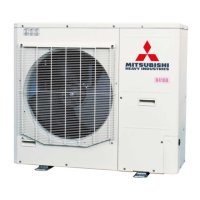
